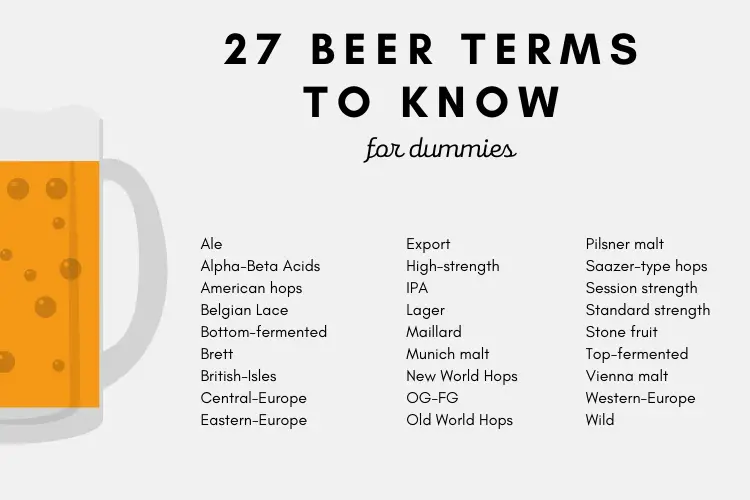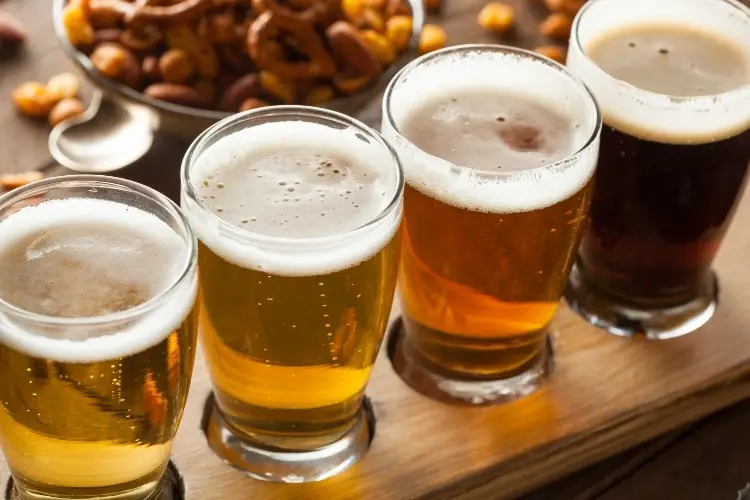Beer is a world on its own. Knowing or learning some beer terms will help you understand why you like a certain beer or not.
Besides, you will become better at remembering the beers and styles of beers you prefer to taste, drink and buy.

1) Ale
Ale beers are top-fermented beers fermented by Saccharomyces cerevisiae yeasts.
They offer aromas reminiscent of fruits.
They can be transparent or dark, light or heavily alcoholic.
Most craft beers are ales.
2) Alpha-Beta Acids
Alpha acids and Beta acids are present in hops.
Both acids influence the bitterness in beer and play a role in the beer’s hoppy aromas.
All hops have both types of acids.
European or noble hops are more balanced with ratios close to 1:1 while New World hops are often higher in alpha acids and provide more consistent bitterness, high-alpha hops can be used as ‘finishing’ hops.
3) American hops
Modern hops, often hybrids designed to underline particular flavors or aromas.
Very common during the craft beer era and mostly bred in Washington and Oregon.
Some of the most famous hops are American hops, and they often bring to the beer citrusy, resiny or herbal aromas along with scents of tropical fruit.
Ex: Cascade, Citra, Centennial, Chinook.
4) Belgian Lace
Lacing is the persistent foam that forms in a glass as the beer is poured or sipped on.
Common when talking about Belgian beers, lacing is a sign of high quality.
5) Bottom-fermented
Bottom ferment beers are fermented with lager yeasts Saccharomyces carlsbergensis (pastorianus) that work at the bottom of a fermenting vessel.
These yeasts produce clean, crisp beers with little noticeable aromas.
They’re more about a refreshing mouthfeel.
They need lower temperatures to ferment.
6) Brett
Aromas coming from the Brettanomyces wild yeast.
When not overwhelming, they can be pleasant offering leather and gamey notes, but too much Brett makes the beer smell like horse sweat, barnyard and funk.
Most of the time a beer flaw, but some styles rely on Brett, including some sour Belgian beers.
7) British-Isles
Traditional beers from England, Wales, Scotland or Ireland.
Ex: British Bitter, English Porter, Scottish Ale.
8) Central-Europe
Traditional beer styles from Germany, Austria, Czech Republic, Scandinavia.
Ex: Pilsner, Helles, Festbier.
9) Eastern-Europe
Traditional beer styles from Poland, Baltic States and Russia.
Ex: Baltic Porter.
10) Export
Although not universally defined by law, beers labeled as ‘export’ are produced for foreign markets and might be higher in alcohol.
Quality might be better too.
There’s no need for making purchasing decisions based on the term export alone.
11) High-strength
Beers with alcoholic strength between 6% and 9%.
Over nine, they’re considered very-high-strength.
Specialty beers can reach over 20% alcohol, although these are rarities and might be unbalanced.
12) IPA
India Pale Ale, hoppy beers made with high amounts of hops, often dry-hopped, fruit-forward and bitter.
Beers were initially created stronger to withstand long travels from England to India.
Now the style is replicated worldwide, and there are stronger versions labeled as Imperial, Double or Triple IPAs.
13) Lager
Lager beers are bottom-fermented at low temperatures with Saccharomyces carlsbergensis yeast.
These beers can be clear or dark, light or heavily alcoholic, but have little noticeable aromas.
Most commercial beers are lagers.
14) Maillard
Aromatic and flavor compounds developed during malt roasting.
Caramel, toasted bread and vanilla are some of the Maillard aromas you can find in beer made with roasted and dark malts.
Ex: Czech Dark Lager, Dunkles Bock, Weizenbock.
15) Munich malt
A traditional German type of malt that gives beers a malty backbone and bready flavors.
Most malty beers use this type of malt, often recognizable for toasted aromas.
Ex: Czech Amber Lager, Märzen, Munich Dunkel.
16) New World Hops
A category comprising American, Australian and New Zealand hops.
They’re often bold, tropical, intense and aromatic, with high levels of alpha acid.
These modern hybrids are popular for current craft styles.
Ex: Citra, Galaxy, Nelson Sauvin, New Zealand Cascade.
17) OG-FG
Original gravity and final gravity.
Technical terms that show the initial and final densities (sugar) in fermentable worts.
High OG and FG are related to bold, full-bodied styles.
18) Old World Hops
Traditional hops from Europe that have been used for centuries.
British, Czech and German hops are a good example.
Floral, spicy and earthy, and less intense than New World hops, these hobs give flavor to the world’s most classic styles.
Ex: Fuggle, Goldings, Hallertauer, Saaz.
19) Pilsner malt
Slightly sweet and light, with mildly toasty, honeyed aromas.
Widely used in light lagers and ales, including the classic Pilsner style.
Ex: Czech Pale Lager, Munich Helles, German Pils.
20) Saazer-type hops
These are called the Noble hops and include the most ancient varieties behind the most classic European beers.
Herbal, earthy and floral, these give a mild character to beers.
Ex: Hallertau, Hersbrucker, Saaz, Tettnanger, Spalt.
21) Session strength
Beers with alcoholic strength below 4% ABV.
Beers with high drinkability giving the ability to drink several of them in a single ‘session’. Often balanced and not overwhelming in bitterness, flavor or aromas.
22) Standard strength
Beers with alcoholic strength between 4% and 6%.
Most commercial lagers and entry-level pale ales fit this category; few beer styles fall above or below these alcohol levels.
23) Stone fruit
Fruits with a single large pit, including apricots, peaches, plums, cherries and mango.
Ex: Brett Beer, American Pale Ale, American IPA.
24) Top-fermented
Beers fermented with ale yeasts (Saccharomyces cerevisiae) that float in the fermenting must.
They produce aromatic beers reminiscent of fruits.
These yeasts require warmer temperatures to do their work.
25) Vienna malt
This type of medium-roasted malt adds malty, bready flavors to beer but never toasty.
Untoasted bread characterizes this mild malt.
Ex: Doppelbock, Vienna Lager, Dunkles Bock.
26) Western-Europe
Traditional beer styles from Belgium, France and Netherlands.
Ex: Flanders Red Ale, Lambics, Trappist Ales.
27) Wild
Wild fermented beers are traditional in countries with old brewing traditions like Belgium.
Beers are fermented by native yeast present in the environment.
The yeast is unpredictable but renders original brews, often with unique, funky aromas and might have some sourness.

